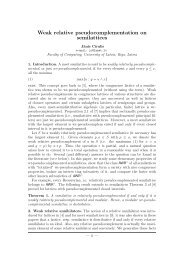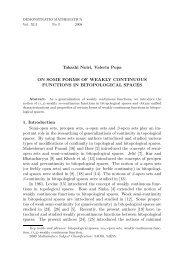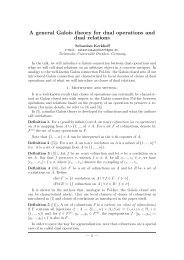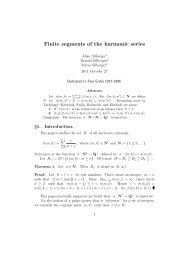(A) IN G-METRIC SPACES 1. Introduction In 1922, Banach
(A) IN G-METRIC SPACES 1. Introduction In 1922, Banach
(A) IN G-METRIC SPACES 1. Introduction In 1922, Banach
Create successful ePaper yourself
Turn your PDF publications into a flip-book with our unique Google optimized e-Paper software.
Weakly Compatible maps of type (A) in G-metric spaces 903<br />
Proposition <strong>1.</strong>2. [7] If (X,G) is a G-metric space then the following are<br />
equivalent:<br />
(1) The sequence {xn} is G-Cauchy,<br />
(2) for each ǫ > 0 , there exist a positive integer N such that G(xn,xm,xm) <<br />
ǫ for all n,m ≥ N.<br />
Proposition <strong>1.</strong>3. [7] Let (X,G) be a G-metric space. Then the function<br />
G(x,y,z) is jointly continuous in all three of its variables.<br />
Definition <strong>1.</strong>4. [7] A G-metric space (X,G) is called a symmetric Gmetric<br />
space if G(x,y,y) = G(y,x,x) for all x,y in X.<br />
Proposition <strong>1.</strong>4. [7] Every G-metric space (X,G) will defines a metric<br />
space (X, dG) by<br />
(i) dG(x,y) = G(x,y,y)+G(y,x,x) for all x,y in X.<br />
If (X,G) is a symmetric G-metric space, then<br />
(ii) dG(x,y) = 2G(x,y,y) for all x,y in X.<br />
However,if (X, G) is not symmetric, then it follows from the G-metric properties<br />
that<br />
(iii) 3/2G(x,y,y) ≤ dG(x,y) ≤ 3G(x,y,y) for all x,y in X.<br />
Definition <strong>1.</strong>5. [7] A G-metric space (X,G) is said to be G-complete if<br />
every G-Cauchy sequence in (X,G) is G-convergent in X.<br />
Proposition <strong>1.</strong>5. [7] A G-metric space (X,G) is G-complete if and only<br />
if (X,dG) is a complete metric space.<br />
Proposition <strong>1.</strong>6. [7] Let (X,G) be a G-metric space. Then, for any<br />
x,y,z,a in X it follows that:<br />
(i) If G(x,y,z) = 0, then x = y = z,<br />
(ii) G(x,y,z) ≤ G(x,x,y)+G(x,x,z),<br />
(iii) G(x,y,y) ≤ 2G(y,x,x),<br />
(iv) G(x,y,z) ≤ G(x,a,z)+G(a,y,z),<br />
(v) G(x,y,z) ≤ 2<br />
3 (G(x,y,a)+G(x,a,z)+G(a,y,z)),<br />
(vi) G(x,y,z) ≤ (G(x,a,a)+G(y,a,a)+G(z,a,a)).<br />
Definition <strong>1.</strong>6. [7] Let (X,G) and (X 0 ,G 0 ) be G-metric spaces and f<br />
:(X,G) → (X 0 ,G 0 ) be a function, then f is said to be G-continuous at a<br />
point a ∈ X if and only if, given ǫ > 0 there exists δ > 0 such that x,y<br />
in X and G(a,x,y) < δ implies G 0 (f(a),f(x),f(y)) < ǫ. A function f is<br />
G-continuous at X if and only if it is G-continuous at all a ∈ X .








